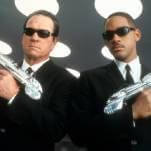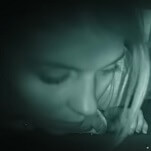Oxford’s TTNG (a.k.a. This Town Needs Guns) has been working up dashing math-rock compositions for over a decade, but it’s always avoided being pigeonholed. And on Disappointment Island—coming July 8 on Sargent House—the trio’s offered up its most accessible, pop-minded batch of songs yet. The A.V. Club is premiering the album’s opening track, “Coconut Crab,” below, and it shows TTNG at its most streamlined. Guitarist Tim Collis still concocts inhuman riffs, the likes of which make it hard to believe he’s the band’s lone guitarist. It makes bassist-vocalist Henry Tremain’s ability to find space for sing-along melodies all the more notable, as he flutters atop the ornate composition and never lets the song’s knotty rhythms get the best of him. Tremain also wrote a lengthy explanation of the song’s genesis, along with demos of the track, all of which can be found below.
Chris and Tim emailed me a couple of recordings of new ideas they’d started working on in a jam session they had had at their parents house in Dorset at the beginning of 2015. “Coconut Crab “was one of these ideas. It instantly stood out for it’s simplicity, space and “openness”—this was a song that left a lot of potential for melody. Which is very exciting from a vocal standpoint.
I also loved that the interest in the main section (which I guess could now be considered the verse) came from a harmonic change. The rhythm (drums and picking pattern) hardly deviates from a six beat pattern (there is change, but it’s subtle), but the variation that keeps it interesting comes in the form of a chord change were the tonal root shifts down a full tone—from D# major to C# major. This is striking enough of a change to give these two subsections of this “verse” a really different feel, even though the rhythmic elements are practically the same. I also loved how this “verse” section was the main meat of the song, and the other sections served as a short break to cleanse the palate before returning you to the main jam. I love it in pop music when a band jams on the same idea for a whole song using dynamic, textural and melodic variations to keep the interest (see “One Thing” by Amerie, “Hey ya!” by OutKast and any song by Talking Heads). “Coconut Crab” isn’t that type of song, but it’s pretty close for a ttng song.
In April I came down to jam with the boys in Dorset with the intention of working on new material, and for the first time I start to work out some parts to Coconut Crab. Before getting going on bass parts I took the time to consider how I wanted to tune my instrument. I should preface this first by saying I play a custom made “bass” guitar based on the Fender Bass VI. A few of Tim’s newer ideas at the time would often float around F and have lots of sharps and flats – this paired with a dissatisfaction for the string gauges of D’addario’s standard Bass VI set, led me to tune the bottom 3 strings up from standard a semi-tone – I then messed around with the other strings while Tim played, trying not to stray too far from their intended pitch, and ended up with a tuning that is basically a standard bar chord with a 2nd at the base (F, A#, D#, G, A#, D# – 2nd, 5th, root octave, 3rd octave, 5th octave, root double octave). One of the main benefits of an alternative tuning is that you get to throw out your knowledge of chord shapes, and the patterns that make up scales and intervals and instead you’re forced to explore blind across the fret board guided only by your ears. So I started messing around on the instrument while Tim played his parts until I found a couple of chord shapes that I really enjoyed. I then started to arpeggiate the chords sliding between them and moving the fingering around until a melody started to emerge.
This process of composition is how I think an awful lot of musicians work – less the calculating author planning out how the song will go, and more an observational director, listening to the fingers chaotically experiment until something catches your ear—“Wait what was that? Play that again!”Often once a riff starts to form itself from the evolution of this trial and error, at some point I’ll start to hear how it should go. A certain pitch or harmony will pop into my head and it’ll then be the task of finding where those notes are on the instrument and seeing if I was right and they work. I remember that happening with the start of “Coconut Crab,” where the close harmony of a semi-tone made it’s way into my mind, and luckily it conveniently involved the same pitch as one of the open strings in this new tuning and so was easy to achieve – I tried it, loved it and it’s in there.
Close harmonies are one of my favourite things as on their own they sound alarmingly dissonant, but when placed in the right harmonic context can sound beautiful. I enjoyed this new melody, although not what most would want from a bass part, it suited the section well and there’s something nice about a melody part like this coming from a lower registered instrument. I then decided to contrast this melody by playing a more conventional “bass line” in the second subsection of the verse (the chord change to C# major). With the exception of the end of the song, the rest of the bass parts came together really quickly while jamming during the afternoon. I was on such a buzz about the song that I took my bass to the spare room I was staying in that evening, and jammed to the demo until I was able to put something more concrete together for the ending.
We had been offered to open for American Football during their UK tour later that year in May, and in the spirit of moving things forward for the album we decided that this would be a good deadline for finishing some new songs. We decided that we’d try and get three new songs ready to play: “Coconut Crab,” “Sponkulus Nodge,” and a song we never played and are still yet to finish called “Penultimation.” This meant I would have to get serious about finishing off vocals for these songs. Sometimes vocal melodies appear to me and it’s clear that that’s how it should be sung, but most of the time I’ll grab a mic and just record myself improvising melodies until things start to work. Lyrics very occasionally appear with melody, but not often, and then very very occasionally lyrics appear first and bring melodies with them.
The music that TTNG produce is often so melodically dense that finding a vocal melody that fits and compliments what’s going on can be incredibly tricky. Lyrics are always forced to take a back seat. I sometimes think of the vocals in this band as a way of offering a simple point to focus on – Although the musicianship is complex and the time’s changing all over the place, there’s a simple catchy melody that you can listen to and just let all that other stuff happen in the background. This does lead to a lot of compromise. I’ll often pull the melodic tempo back so as to simplify the combined result of band and voice – this will mean that the potential beats to hang syllables on are few and far between. constructing meaningful sentences out of such few syllables is something I do not find easy—or am easy about.
I am strangely fussy about lyric writing – it has to be something meaningful to me. Even if it’s so soaked in metaphor and subterfuge to deliberately prevent others from understanding what is meant, it still has to have meaning at it’s root. I also love word play and find myself getting hooked on making things rhyme. Making all this fit over predetermined melodies and their predefined syllable spacing, in a way that I find satisfactory, can be nothing short of torture. It seemed, what with the tight deadline for having this song finished and ready to perform, that lyric writing and my difficulty with it seemed to be the perfect subject matter for this song.
TTNG tour dates
Jul-21 San Francisco, CA – Thee Parkside
Jul-22 Los Angeles, CA – Teragram Ballroom
Jul-23 San Diego, CA – The Irenic
Jul-24 Scottsdale, AZ – Pub Rock Live
Jul-26 Tucson, AZ – Club Congress
Jul-27 Albuquerque, NM – Launchpad
Jul-28 El Paso, TX – 5points Patio
Jul-29 Dallas, TX – Club Dada
Jul-30 Austin, TX – Sidewinder
Jul-31 Houston, TX – White Oak Music Hall
Aug-02 Nashville, TN – High Watt *
Aug-03 Atlanta, GA – Masquerade (Purgatory)*
Aug-04 Chapel Hill, NC – Local 506*
Aug-05 Washington, DC – DC9*
Aug-06 New York, NY – Studio at Webster Hall*
Aug-07 Philadelphia, PA – The Foundry*
Aug-09 Boston, MA – Great Scott*
Aug-10 Hamden, CT – The Space
Aug-11 Pittsburgh, PA – Smiling Moose
Aug-12 Grand Rapids, MI – Pyramid Scheme
Aug-13 Chicago, IL – Subterranean
Aug-18 Bristol, UK – ArcTanGent Festival
Aug-20 Dublin, IR – The Button Factory w/toe, Steve Strong, Yonen
* LITE supporting








































